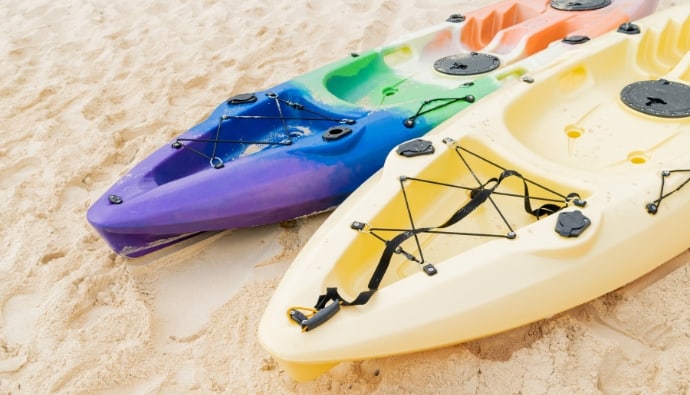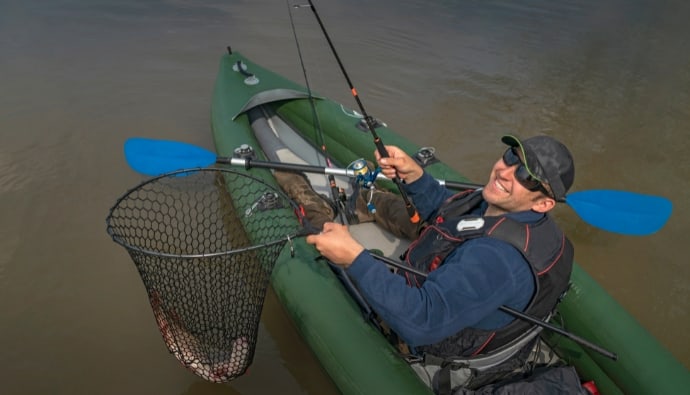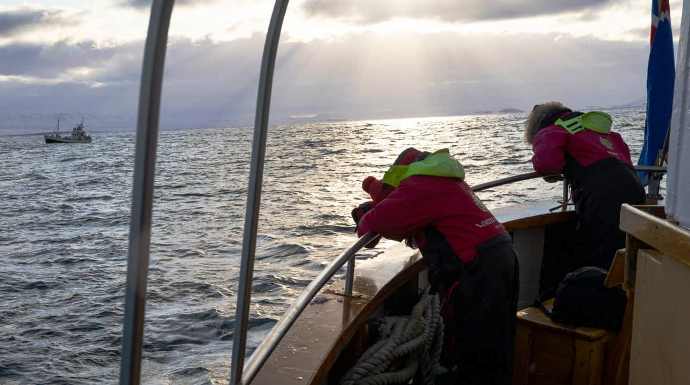There might be times when you don’t have a roof rack to carry your kayak. Fret not! You can still transport a kayak without relying on a roof rack for your vehicle.
In this article, we’ll unveil simple, practical solutions, tips, and methods that enable you to transport your kayak without a roof rack.
This way, you can focus on enjoying your time on the water worry-free.

How to Transport a Kayak Without a Roof Rack Using Foam Blocks or Pool Noodles
A foam block and pool noodle can be your trusty companions.
These soft, cushiony materials can be transformed into supportive cradles for your kayak, ensuring its safety and stability during your drive.
Here’s a step-by-step guide on using these to transport your kayak:
- Gather two foam blocks or pool noodles.
- If using pool noodles, trim them to match the width of your vehicle’s roof. This guarantees a snug fit and even support.
- Position the foam blocks or pool noodles on your vehicle’s roof, ready to securely cradle your kayak. Imagine that the blocks or pool noodles are your reel roof racks.
- Space your pool noodles evenly, so your kayak is well-balanced. Make sure they’re parallel and positioned at the front and back of where the kayak will sit.
- Lay your kayak on the foam blocks or pool noodles. Make sure it’s centered and stable. The cockpit should be facing up, and the hull should rest on the foam supports.
- Secure the kayak to your vehicle with straps or ropes. Start at the front of the kayak. Pass a strap or rope through the front grab handle or attachment point, then loop it around your vehicle’s front bumper, tow hook, or other secure points.
- Tighten the strap or rope, pulling the kayak snugly against the foam supports. Be sure it’s secure but not too tight, as you don’t want to damage your kayak.
- Repeat this process for the back of the kayak. Attach another strap or rope to the rear grab handle or attachment point and loop it around your vehicle’s rear bumper or another secure point.
- Double-check your kayak is secure.
Give it a gentle shake to ensure it doesn’t move. If it does, adjust the straps or ropes until it’s stable.
Now your kayak is safely secured, and you’re ready to hit the road!
How to Transport a Kayak Without a Roof Rack Using a Kayak Trailer
Opting for a kayak trailer is a fantastic alternative.
Choosing a trailer over a roof rack comes with some remarkable perks, making the transportation of your kayak both easier and safer.
Reasons to Use a Kayak Trailer
Here’s why a trailer could be the perfect solution for you:
Effortless loading and unloading
A kayak trailer eliminates the need to hoist your kayak onto your vehicle’s roof. This simplifies and enhances the safety of loading and unloading your kayak, especially when you’re going solo.
Protection for your vehicle
By using a kayak trailer, you can safeguard your car’s roof from potential scratches and damages that may occur while loading and unloading a kayak.
More space
Using a kayak trailer frees up space on your vehicle’s roof. This is great if you need to carry other gear or additional kayaks.
Different Types of Kayak Trailers
There are different types of kayak trailers available:
Single-kayak trailers.
Tailored for transporting a single kayak, these trailers are ideal for lone explorers or those constrained by storage space.
Multi-kayak trailers.
These trailers can carry multiple kayaks at once. They’re great for families or groups of friends who enjoy kayaking together.
Combination trailers.
These versatile trailers can carry kayaks and other gear, such as bikes, canoes, or paddleboards. They’re perfect for those who enjoy various outdoor activities.
Things to Consider When Choosing a Kayak Trailer
To choose the right kayak trailer for your needs, consider:
- How many kayaks do you need to transport?
- Your storage space. Make sure the trailer fits in your garage or storage area when not in use.
- Your budget. Kayak trailers cater to various budgets. Discover one that suits your financial plan without sacrificing quality.
A fitting kayak trailer can safely and efficiently transport your kayak, making your next adventure even more delightful.
Inflatable Kayaks: A Convenient Option
Inflatable kayaks are game-changing.
These innovative kayaks boast a lightweight design, easing transportation and storage. They offer incredible benefits compared to their hardshell counterparts.
Reasons to Have an Inflatable Kayak
Here’s why an inflatable kayak might be your perfect match:
- Effortless portability.
Inflatable kayaks are significantly lighter than traditional hardshell kayaks, making them a breeze to carry, even over long distances.
- Seamless transportation.
Deflated inflatable kayaks occupy minimal space, allowing you to stow them in your car’s trunk or back seat, eliminating the need for a roof rack.
- Space-saving storage.
Easily store inflatable kayaks in compact spaces, such as a closet or garage, when not in use. This is great if you have limited storage at home.
Tips for Inflating and Deflating Your Kayak
Here are some tips for inflating and deflating your inflatable kayak for transport:
- Inflate the kayak using a pump.
Most inflatable kayaks come with a hand or foot pump. Use the pump to inflate your kayak according to the manufacturer’s instructions. Make sure it’s firm but not overinflated, as this could damage the kayak.
- Double-check the air valves.
Ensure all air valves are securely closed to prevent air from leaking out during transport.
- Use a carrying bag.
Many inflatable kayaks come with a carrying bag. Place your inflated kayak in the bag for easy carrying and to protect it from dirt or damage during transport.
- Deflate the kayak after use.
When you’re done kayaking, open the air valves and let the air out. Gently press on the kayak to release any remaining air.
- Dry and fold the kayak.
Make sure your inflatable kayak is completely dry before folding it up for storage. This will help prevent mold and mildew from forming.
Other DIY Roof Rack System Solutions for Transporting Kayaks
You can make your own makeshift rack using everyday materials like PVC pipes or wood. These DIY options can be affordable and fun to build.
PVC pipe kayak rack.
A PVC pipe rack is lightweight and affordable. To build this rack:
- Purchase PVC pipes, elbows, and T-joints from your local hardware store.
- Measure and cut the PVC pipes to fit your vehicle’s roof dimensions and your kayak’s size.
- Assemble the pipes using elbows and T-joints to create a frame that supports your kayak.
- Secure the PVC frame to your vehicle’s roof using straps or bungee cords.
Wooden kayak rack.
A wooden rack can be a sturdy and durable choice. To build a wooden kayak rack:
- Gather lumber, screws, and brackets from your local hardware store.
- Measure and cut the lumber to fit your vehicle’s roof dimensions and your kayak’s size.
- Assemble the wooden frame using screws and brackets to create a supportive structure for your kayak.
- Attach the wooden frame to your vehicle’s roof using heavy-duty straps or bungee cords.
Pool noodle and ratchet strap rack.
This simple solution uses pool noodles and ratchet straps to create a makeshift rack:
- Purchase pool noodles and ratchet straps from your local store.
- Cut the pool noodles to the width of your vehicle’s roof.
- Slide the ratchet straps through the pool noodles.
- Place the pool noodles on your vehicle’s roof, spaced evenly apart.
- Secure the ratchet straps inside your vehicle, tightening them to hold the pool noodles in place.
- Lay your kayak on the pool noodles and use additional ratchet straps to secure it.
Remember to test the stability of your DIY kayak rack before hitting the road. Ensure your kayak is secure and well-supported to prevent any accidents or damage during transportation.
With these creative DIY solutions, you can transport kayaks without a roof rack and enjoy a sense of accomplishment from building your own transportation solution.
Safety Tips for Kayak Transportation Without a Roof Rack
Safety should always come first.
When transporting your kayak without a roof rack, it’s essential to be aware of local laws and regulations. Different areas might have specific rules about how kayaks must be secured and transported on vehicles.
Here are some general safety tips for transporting your kayak without a roof rack:
Check local laws and regulations.
Before you hit the road, research the rules for kayak transportation in your area. Ensure compliance with all requirements, such as attaching red flags to overhanging kayaks or using specific strap types for securing them.
Properly secure your kayak.
No matter if you’re utilizing foam blocks, pool noodles, a DIY rack, or a trailer, it’s crucial to fasten your kayak securely to your vehicle. Thoroughly inspect all straps, ropes, or bungee cords, making sure they’re tight and correctly fastened.
Assess your kayak’s stability.
Before hitting the road, gently shake your kayak to confirm it’s stable and doesn’t budge. If it does, adjust the straps or ropes until it’s stable and secure.
Drive with caution.
When transporting a kayak, drive at a safe speed and avoid sudden stops or sharp turns. Be extra cautious in windy conditions, as strong gusts can cause your kayak to shift or sway.
Monitor your kayak during your trip.
Regularly check your kayak during your journey to ensure it remains secure. If you notice any loosening or movement, pull over and tighten the straps or ropes as needed.
Use proper signaling and visibility equipment.
If your kayak extends beyond your vehicle’s rear, attach a red flag or reflective material to the end of the kayak to increase visibility for other drivers. Also, ensure your vehicle’s brake lights and turn signals are visible and not obstructed by the kayak.
By following these safety tips, you can ensure a safe and stress-free journey while transporting your kayak without a roof rack. Enjoy your adventure knowing that you’ve taken the necessary precautions to protect both your kayak and fellow travelers on the road.
Conclusion
Transporting a kayak without a roof rack is possible.
Throughout this article, we’ve explored various methods to help you transport your kayak safely and efficiently. These options include:
- Using foam blocks or pool noodles for cushioned support.
- Utilizing a kayak trailer as an alternative to a roof rack.
- Opting for an inflatable kayak for easy transportation and storage.
- Creating your own DIY solutions, such as a PVC pipe or wooden rack.
- Following safety tips to ensure secure and legal transportation.
Each method has its advantages, and the best option for you will depend on your needs, budget, and personal preferences. Always prioritize safety when choosing and implementing a kayak transportation solution.
With the right method, you can transport your kayak without a roof rack and embark on your next adventure with confidence. However, if you really enjoy kayaking, it’s best to invest in a quality car roof rack system. Happy kayaking!





 Facebook
Facebook YouTube
YouTube








